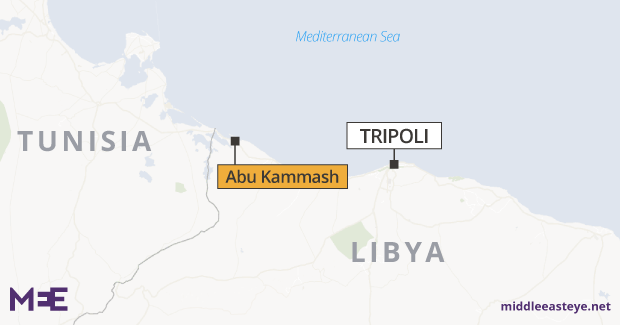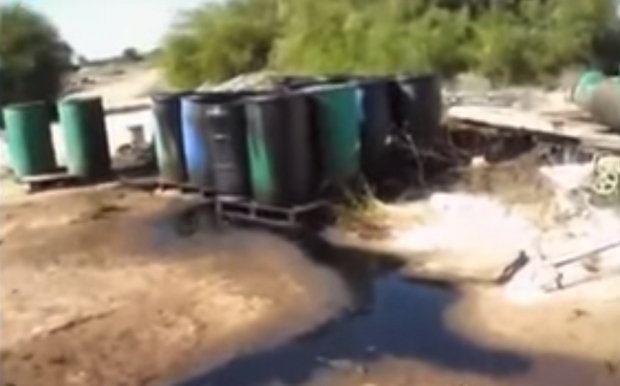Gaddafi's toxic legacy: The abandoned chemical plant poisoning Libyans
ZUWARA, Libya - A dusty gas mask left at the perimeter guard post hints at what lies beyond. Amid mounds of rubbish, broken furniture and loops of razor wire, abandoned chemical silos, factories and office blocks jut from the desolate scrub.
Ibrahim recalls the day almost 40 years ago when this place, Abu Kammash on Libya's western coastline, offered overseas adventure and a well-paid career. He was one of many Libyans sent in the late 1970s to study in Europe, and then work at this huge petrochemical complex known as GCCI.
The Germans followed strict protocols on toxic waste. In Libyan hands, there were two options: bury it, or dump it in the sea
- Ibrahim, former GCCI worker
"How could I possibly say no to such an offer?" he asks. A generation on, Ibrahim says it was the worst decision of his life, which has cost him and the family he raised under its shadow in Zuwara.
Abu Kammash, known locally as Bukamesh, was abandoned in 2010 after years of mismanagement by Gaddafi's Libya, leaving sea and soil polluted, the ocean's natural bounty poisoned and, locals say, many who lived nearby ill and even dead.
And due to ongoing war and instability, and the lack of expertise to decommission the site, next to nothing has been done to contain the aftermath. Poisons such as mercury and cadmium continue to leech into the environment and, as decay sets in, locals say the effects are worsening.
A slow death sentence
For more than 30 years, Abu Kammash produced millions of tonnes of salt, plastics and industrial chemicals. Its first 15 years were managed by German experts, Ibrahim said, before it was taken over by Libya's government in 1996.
"That was the beginning of the end," says Ibrahim. "The Germans followed strict protocols to treat toxic waste. As soon as the plant fell into Libyan hands, there were two options: bury it nearby, or dump it in the sea."
From that point, Ibrahim said, workers were condemned to a slow death sentence.
The biggest issue was the use of mercury, a highly toxic heavy metal used in electrolysis to create industrial chemicals such as chlorine and sodium hydroxide. Despite a global effort at the turn of the century to ban its use, after disasters in Canada and Japan, Abu Kammash under Gaddafi changed none of its processes.
"Changing the whole system would have been too costly," says Ibrahim. Workers had blood tests taken every six months, showing dangerous and even potentially fatal levels of mercury, but the tests, he said, were "merely a formality", and the results were ignored.
Fahed Garab, the head of surgery at Zuwara hospital and an A&E doctor in Abu Kammash between 2008 and 2009, said there are simply "no medical statistics of any kind" on the effects of the pollution.
However, Garab said safety conditions at the plant were "very bad", and official studies showed one in 10 villagers in nearby Bukamesh had high levels of mercury in their bodies.
"The percentage increased among staff at the electrolysis plant, where half showed elevated levels of mercury," he said.
Staff at the electrolysis plant... half showed elevated levels of mercury
- Fahed Garab, Zuwara head surgeon
Ibrahim says many of these workers fell seriously ill or died.
"Even after closure, a Tunisian laboratory was diagnosing former electrolysis workers with high levels of mercury poisoning. It's a miracle they are still alive."
But the poison did not stop at the factory gates, nor at the village nearby. Ibrahim is convinced it has caused sickness among people in Zuwara, 10 miles along the coast.
In 2014, Ibrahim's 19-year-old daughter Sara was diagnosed by the Red Crescent with Friedreich's ataxia, a debilitating disease associated with mercury poisoning that causes progressive damage to the nervous system.
Problems with motor coordination is one of the first signs, and victims often end their lives in a wheelchair.
Ground zero
In Zuwara, environmental volunteers are trying to get to grips with the disaster that is Abu Kammash, but the site is too dangerous to tackle alone.
Sadiq Jiash, the head of the town's emergency committee, recalls how the site stood abandoned for a year before anyone could gain access. In 2011, after Gaddafi lost control of the Tunisian border area during the Libyan uprising, he was one of the first to enter.
When we finally got inside we could hardly believe what we saw
- Sadiq Jiash, Zuwara emergency committee
"When we finally got inside we could hardly believe what we saw," said Jiash. Nothing inside had been closed down, and years of neglect had contributed to myriad leaks of ethylene, hydrochloric acid and other toxic substances from pipes and tanks.
"Any attempt to close anything down could have caused an explosion, and we dared not touch anything," he said.
In the Zuwara offices of Bado, an environmental group, photos line the walls of work by volunteers at Farwa.
Farwa was Libya's only island before it was artificially connected to the mainland in the early 2000s as part of project by Gaddafi's second son, Saadi, to build a coastal metropolis and an international investment zone.
Bado's president, Shokri Dahe, says that has compounded the effects of Abu Kammash's pollution.
Waters became increasingly polluted because of the reclamation project, says Dahe. In 2013, Bado sent samples of grass, earth and water from Farwa to a laboratory in Tunisia for analysis.
"The pollution levels were so brutal that they had to repeat the tests twice to make sure they were not wrong."
The presence of toxic waste in the surrounding area was corroborated by a 2015 joint study by the University of Sabratha and several Malaysian institutions.
It found heavy metals such as mercury, copper, lead and cadmium on nearby farms, all of which, if ingested in unsafe amounts, can be linked to cancer in humans.
The report said that while the concentrations were low, there was concern of transmission to humans via the food chain - the area is home to olive groves where fruit is pressed for oil.
In a 2016 investigation on Farwa island, mercury levels far in excess of international safety levels were found in a vast array of ocean life.
Many samples contained several times the maximum safe levels agreed by UN health authorities.
The fish, still being caught by locals, are now filled with poison.
Years of work ahead
Such levels of pollution, and the effects, will take years to conquer. The task is compounded by the lack of any central authority in Libya, where three governments vie for power and use a patchwork of militias for fight their battles.
Adel Ashur Banana, an environmental engineer who joint authored the 2015 and 2016 investigations, has nevertheless started his own mission to get the site cleaned up. It is small, and poorly financed, but it is a start.
Once we have stored the chemicals, the next step will be to clean the farms and Farwa
- Adel Ashur Banana, environmental engineer
"So far we've removed some highly corrosive chemical elements and stored them in Zuwara but we rely on the little money we get from people who deal with scrap to keep working," Adel said in a telephone interview.
"Once we have stored the chemicals, the next step will be to clean the farms and the beautiful island of Farwa."
The latter will likely be a much bigger challenge. Banana and his team have recently found out that even the seaweeds contain high levels of lead.
Zuwara's mayor, Hafed Bensasi, says a joint delegation from Zuwara alongside members of the industry ministry in Tripoli have discussed a comprehensive clean-up programme with an Italian firm, but provided no further details.
"We want to dismantle the plant and clean up the environment," he said. "We want to make sure that there are guarantees that a disaster like this does not happen again," the mayor says.
He admitted no agreement had been struck and seven years on from its abandonment, Abu Kammash remains a sore on Libya's landscape.
For Ibrahim, the task is just too big to manage.
"There are thousands of tonnes of contaminated soil and it will take tonnes of money to get rid of it," he says.
And his family has more immediate problems to deal with.
"I just need someone to treat my daughter, that's all I'm asking for today."
This article is available in French on Middle East Eye French edition.
Middle East Eye propose une couverture et une analyse indépendantes et incomparables du Moyen-Orient, de l’Afrique du Nord et d’autres régions du monde. Pour en savoir plus sur la reprise de ce contenu et les frais qui s’appliquent, veuillez remplir ce formulaire [en anglais]. Pour en savoir plus sur MEE, cliquez ici [en anglais].










